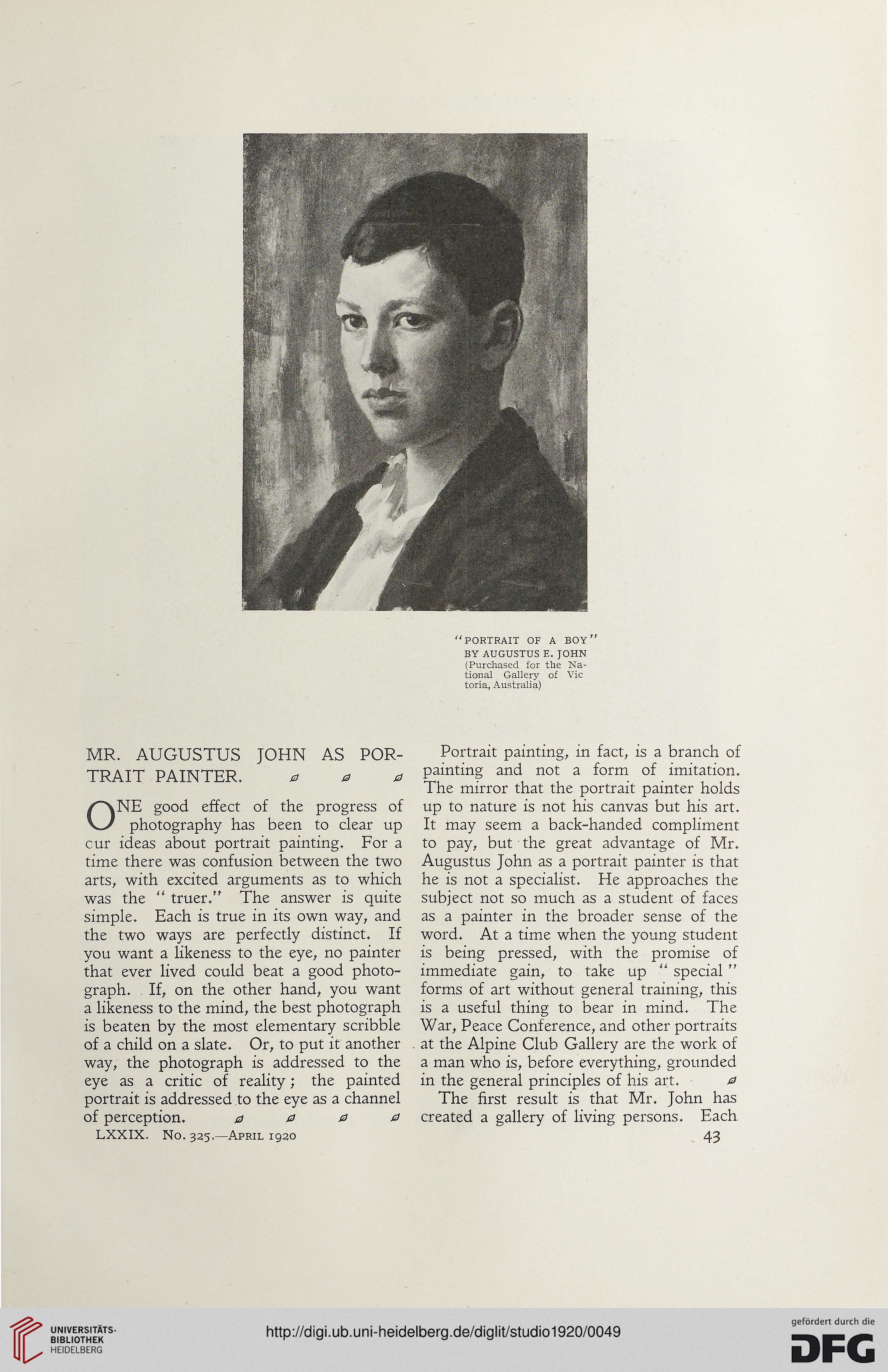"PORTRAIT OF A BOY ”
BY AUGUSTUS E. JOHN
(Purchased for the Na-
tional Gallery of Vic
toria, Australia)
MR. AUGUSTUS JOHN AS POR-
TRAIT PAINTER. 000
ONE good effect of the progress of
photography has been to clear up
cur ideas about portrait painting. For a
time there was confusion between the two
arts, with excited arguments as to which
was the “ truer.” The answer is quite
simple. Each is true in its own way, and
the two ways are perfectly distinct. If
you want a likeness to the eye, no painter
that ever lived could beat a good photo-
graph. If, on the other hand, you want
a likeness to the mind, the best photograph
is beaten by the most elementary scribble
of a child on a slate. Or, to put it another
way, the photograph is addressed to the
eye as a critic of reality; the painted
portrait is addressed to the eye as a channel
of perception. 0000
LXXIX. No. 325.—April 1920
Portrait painting, in fact, is a branch of
painting and not a form of imitation.
The mirror that the portrait painter holds
up to nature is not his canvas but his art.
It may seem a back-handed compliment
to pay, but the great advantage of Mr.
Augustus John as a portrait painter is that
he is not a specialist. He approaches the
subject not so much as a student of faces
as a painter in the broader sense of the
word. At a time when the young student
is being pressed, with the promise of
immediate gain, to take up “ special ”
forms of art without general training, this
is a useful thing to bear in mind. The
War, Peace Conference, and other portraits
at the Alpine Club Gallery are the work of
a man who is, before everything, grounded
in the general principles of his art. 0
The first result is that Mr. John has
created a gallery of living persons. Each
43
BY AUGUSTUS E. JOHN
(Purchased for the Na-
tional Gallery of Vic
toria, Australia)
MR. AUGUSTUS JOHN AS POR-
TRAIT PAINTER. 000
ONE good effect of the progress of
photography has been to clear up
cur ideas about portrait painting. For a
time there was confusion between the two
arts, with excited arguments as to which
was the “ truer.” The answer is quite
simple. Each is true in its own way, and
the two ways are perfectly distinct. If
you want a likeness to the eye, no painter
that ever lived could beat a good photo-
graph. If, on the other hand, you want
a likeness to the mind, the best photograph
is beaten by the most elementary scribble
of a child on a slate. Or, to put it another
way, the photograph is addressed to the
eye as a critic of reality; the painted
portrait is addressed to the eye as a channel
of perception. 0000
LXXIX. No. 325.—April 1920
Portrait painting, in fact, is a branch of
painting and not a form of imitation.
The mirror that the portrait painter holds
up to nature is not his canvas but his art.
It may seem a back-handed compliment
to pay, but the great advantage of Mr.
Augustus John as a portrait painter is that
he is not a specialist. He approaches the
subject not so much as a student of faces
as a painter in the broader sense of the
word. At a time when the young student
is being pressed, with the promise of
immediate gain, to take up “ special ”
forms of art without general training, this
is a useful thing to bear in mind. The
War, Peace Conference, and other portraits
at the Alpine Club Gallery are the work of
a man who is, before everything, grounded
in the general principles of his art. 0
The first result is that Mr. John has
created a gallery of living persons. Each
43




